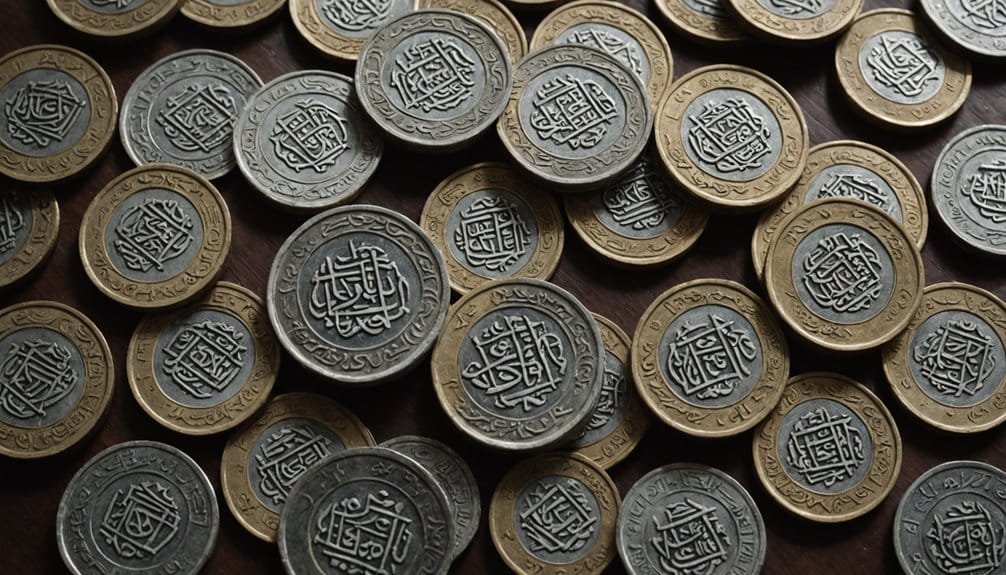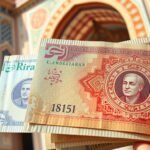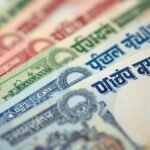
The Yemeni Rial, Yemen's national currency, has weathered complex political and economic challenges since 2014. You'll find its value dramatically impacted by civil conflict, with exchange rates fluctuating wildly between 250-280 YER per USD. The currency's stability has been compromised by dual central bank operations in Aden and Sana'a, causing significant regional monetary divergence. Hyperinflation has eroded purchasing power, with the Rial losing over 80% of its value against foreign currencies. Ongoing armed conflicts, international blockades, and limited central bank interventions continue to destabilize its economic foundation. If you're curious about the intricate dynamics shaping this volatile currency, there's much more beneath the surface.
Key Takeaways
- The Yemeni Rial, historically influenced by Ottoman Piastres, has undergone significant transformations in its monetary system since local coin production began in 1900.
- Political fragmentation between Aden and Sana'a has dramatically impacted the Rial's valuation, causing extreme exchange rate disparities exceeding 280% between regional markets.
- The Yemen Central Bank's operational challenges during ongoing conflict have compromised monetary policy, leading to dual-branch operations and destabilized currency management.
- Economic turmoil has caused the Yemeni Rial to collapse by over 80% against foreign currencies between 2014-2016, reflecting severe macroeconomic instability during civil war.
- Future Rial stability depends on implementing comprehensive monetary reforms, transparent policy frameworks, and attracting international investment to restore economic confidence and currency value.
Historical Origins of Yemen's Currency
The Ottoman Empire's presence considerably influenced Yemen's monetary practices, introducing Piastres as a standard medium of exchange during territorial control. Trade networks fundamentally shaped Yemen's early monetary system, linking regional economic interactions with currency development.
Local economic development accelerated when Imam Yahya strategically smuggled British minting machinery, enabling indigenous coin production from 1900 onward.
The Chomsih, a subsidiary coinage with 120 units per Riyal, represented an important pivotal monetary instrument in Yemen's sophisticated economic landscape.
Central Bank Monetary Management
You'll find that Yemen's Central Bank regulatory powers have been critically compromised by the ongoing conflict, resulting in a fractured monetary policy framework.
The bank's ability to implement cohesive currency strategies has been severely undermined by the dual-branch operations in Aden and Sana'a, which have generated divergent exchange rates and destabilized the Yemeni rial.
Understanding these monetary management challenges requires analyzing the complex interplay between political fragmentation, banking sector disruption, and the systematic erosion of institutional financial controls. In December 2019, the emergence of the e-Rial initiative further complicated Yemen's already fragmented monetary landscape, highlighting the deep structural challenges within the country's financial system.
Bank Regulatory Powers
Amid the complex landscape of Yemen's financial governance, the Central Bank's regulatory powers have emerged as a critical mechanism for maintaining monetary stability and financial oversight.
You'll find that banking compliance is central to its operations, with the ability to conduct thorough financial audits across various financial institutions, including commercial banks, Islamic banks, and microfinance entities.
The Central Bank's supervisory role extends to preventing financial crimes, monitoring international money transfers, and enforcing strict compliance with anti-money laundering regulations.
Its power to control international financial transfer systems like SWIFT enables significant regulatory leverage, potentially isolating non-compliant institutions from global financial networks.
These regulatory mechanisms are designed to strengthen Yemen's financial infrastructure and guarantee transparent, accountable banking practices.
Notably, the Central Bank must navigate the challenges of monetary division, managing competing financial jurisdictions between Sanaa and Aden while attempting to maintain a unified financial system.
Currency Policy Framework
Regulatory oversight naturally segues into the intricate domain of Yemen's currency policy framework, where monetary management represents a complex chess game of economic survival.
You'll find that Yemen's monetary policy lacks a clear inflation targeting mechanism, with the Central Bank of Yemen operating in a fragmented state since 2016. The need for a formal, rule-based framework is critical to guarantee price stability and manage exchange rate dynamics.
Key reforms should focus on implementing a transparent monetary policy rule that reduces central bank discretion. An interest rate rule emerges as the preferred approach, pending necessary liberalization reforms.
The framework must address money demand instability and proactively respond to economic developments, ultimately aiming to achieve low and stable inflation rates across Yemen's divided economic landscape. The ongoing fiscal reform efforts from the Ministry of Finance provide critical momentum for potential monetary system stabilization.
Monetary Stability Strategies
Yemen's complex monetary landscape demands a multifaceted approach to central bank monetary management, with three essential strategic pillars underpinning potential stability efforts.
You'll observe that monetary policy requires maneuvering through the challenges of competing central banks in Aden and Sana'a, which fragment financial governance and complicate inflation control.
Your strategic focus must center on standardizing bank operations, establishing a unified exchange rate, and regulating international financial transfers.
The central bank's interventions, including printing new banknotes and implementing anti-money laundering protocols, aim to stabilize the Yemeni rial's value.
However, these efforts are continuously challenged by limited foreign reserves, currency exchange volatility, and the ongoing conflict's economic disruptions.
Precision in monetary management remains vital for Yemen's financial recovery.
Banknotes and Coin Denominations

The Yemeni rial's monetary landscape encompasses a diverse array of banknotes and coins that reflect the nation's complex economic and political history. Current banknote security features include revised designs introduced after 2017, with denominations ranging from 50 to 1000 rials. Currency stability challenges have significantly impacted the rial's value and circulation across different regions of Yemen.
These notes showcase cultural narratives and historical monuments, enhancing their intrinsic value beyond mere currency.
Coin history reveals a nuanced evolution, with denominations of 1, 5, 10, and 20 rials currently in circulation. Significantly, fils-denominated coins were discontinued post-unification.
The Houthi-led government's recent introduction of a 100 rial coin demonstrates ongoing monetary adaptations. These coins and banknotes represent more than financial instruments; they're tangible markers of Yemen's economic resilience and ongoing transformation.
Yemen's Complex Economic Landscape
Against the backdrop of prolonged conflict and systemic disruption, Yemen's economic landscape emerges as a complex, multifaceted terrain characterized by severe structural challenges and profound resilience.
You'll observe a dramatic economic contraction, with real GDP per capita plummeting 54% between 2015 and 2023, underscoring the intense humanitarian crises gripping the nation. The interplay of regional tensions, conflict-driven fragmentation, and external shocks has precipitated a volatile economic environment where fiscal revenues have declined over 30% and current account deficits have expanded to 19.3% of GDP.
Economic resilience manifests through strategic adaptations: diversification efforts in agriculture, potential renewable energy investments, and critical diaspora remittances. Natural resource potential remains a critical underlying factor for potential economic recovery, with untapped oil and mineral reserves offering significant opportunities for future economic revitalization.
However, sustainable recovery hinges on achieving political stability, reconstructing institutional frameworks, and securing international financial support to mitigate systemic economic vulnerabilities.
Dynamic Exchange Rate Environment

You'll observe stark regional variations in Yemen's exchange rates, with significant disparities emerging between Aden and Sana'a, reflecting the complex political fragmentation that directly impacts currency valuation.
The Houthi-controlled regions maintain distinct monetary policies, effectively creating parallel economic zones with divergent currency management strategies that challenge traditional economic norms.
These regional rate differences aren't merely academic observations, but critical indicators of the profound political instability undermining Yemen's economic infrastructure and monetary coherence. The exceptional regional disparities in exchange rates, which exceeded 280.34% between different regions, underscore the fundamental economic fragmentation confronting Yemen's financial ecosystem.
Regional Rate Variations
Amid Yemen's complex economic landscape, regional exchange rate variations have emerged as a vital factor defining the dynamic currency environment, with disparities between major economic centers like Aden and Sana'a revealing profound economic challenges.
You'll notice these variations dramatically impact regional trade, with exchange rate differences exceeding 280.34% by late April 2024, highlighting significant economic disparities. The real-time conversion rate of 0.01504 SAR for YER demonstrates the intricate nature of these monetary fluctuations.
These regional fluctuations aren't random; they reflect underlying economic instabilities and localized market conditions.
You'd observe how different regions respond uniquely to national economic policies, creating a fragmented monetary ecosystem.
The Central Bank's limited interventions further complicate the scenario, allowing substantial regional divergence in currency valuation.
Understanding these nuanced exchange rate dynamics becomes essential for traversing Yemen's complex economic terrain.
Political Currency Impact
The Yemen Rial's trajectory reveals a stark narrative of political instability's profound currency impact, where prolonged conflict has transformed the economic landscape into a fragmented monetary ecosystem.
You'll observe that currency devaluation consequences stem directly from the territorial split between competing governmental factions, creating parallel economic structures that dramatically destabilize monetary valuation. Economic dependency on imports further complicates the Rial's vulnerability, as the country's limited domestic production intensifies its exposure to external economic shocks.
Conflict economic ramifications manifest through severe foreign reserve depletion and systemic economic fragmentation.
The division of Yemen's Central Bank has exponentially accelerated the Rial's volatility, with exchange rate fluctuations reflecting the intricate political tensions.
You'll recognize how this instability translates into direct economic challenges: diminished purchasing power, escalating import costs, and a fundamentally compromised national financial infrastructure that perpetuates economic vulnerability.
Currency Challenges During Civil War
Yemen's staggering currency collapse during the civil war represents a quintessential example of monetary disintegration under prolonged conflict.
Currency depreciation devastated the Yemeni rial, with its value plummeting over 80 percent against foreign currencies between 2014 and 2016. The inflation impact was catastrophic, forcing families to allocate more than 60 percent of income toward basic food supplies.
The Central Bank's strategic relocation from Sana'a to Aden in 2016 triggered an economic crisis, compounded by printing 6 trillion new riyals without sufficient reserves. Humanitarian aid organizations reported that the currency crisis directly contributed to widespread economic suffering among Yemeni civilians.
Foreign exchange interventions became increasingly challenging as currency holdings diminished. Armed faction taxation, coupled with international blockades, further destabilized monetary systems, creating unprecedented economic volatility that decimated purchasing power and pushed millions toward extreme poverty.
Political Impact on Monetary System

Throughout Yemen's protracted civil conflict, political fragmentation has systematically dismantled the nation's monetary infrastructure, creating a complex landscape of competing central bank branches and divergent currency policies.
You'll observe how the relocation of the Central Bank from Sana'a to Aden in 2016 became a pivotal moment in currency control, fundamentally destabilizing Yemen's financial ecosystem.
The Houthi authorities' strategic interventions, including the prohibition of new banknotes and decrees targeting financial operations, have weaponized monetary policy.
You'll recognize how these political maneuvers deliberately fragment economic institutions, creating parallel financial systems that undermine national economic cohesion.
The result is a destabilized currency environment where political objectives consistently override sound monetary management, rendering the Yemeni rial increasingly vulnerable to manipulation and volatility.
Political control struggles have further intensified the [economic instability across Yemen's fragmented financial landscape.
Future Prospects for Yemeni Rial
Amid the seismic political disruptions destabilizing Yemen's monetary landscape, emerging economic projections for the Yemeni rial (YER) reveal a complex trajectory fraught with systemic challenges.
You'll need to recognize that future economic stability hinges critically on thorough resource management strategies. The YER's potential recovery depends on strategic interventions addressing multiple interconnected factors, including central bank policy reforms, foreign investment attraction, and stabilization of natural resource sectors. Unemployment rate fluctuations signal underlying economic pressures that could further impact currency performance.
Your understanding must encompass the delicate balance between currency valuation and geopolitical dynamics.
Projected exchange rates suggest minimal short-term improvement, with the rial expected to trade around 250.60-251.20 YER per USD.
Successful economic reconstruction will require robust regulatory frameworks, coordinated international cooperation, and targeted economic reforms to mitigate ongoing market volatilities.
Conclusion
Yemen's currency trajectory mirrors its tumultuous geopolitical landscape. With the rial's value plummeting over 60% since 2015's civil conflict, you'll recognize how monetary instability directly reflects national turbulence. Central bank interventions and international humanitarian support haven't fully stabilized the currency. You'll find the Yemeni rial's future hinges on political reconciliation, economic restructuring, and restoration of institutional financial mechanisms. The currency's resilience remains uncertain yet profoundly significant.







Interesting read, but curious, arent the regulatory powers of Yemens central bank somewhat crippled due to the ongoing conflict? How does this impact the Yemen Rials value?
Interesting read on Yemens currency history. But, dont you think the central bank monetary managements role needs more emphasis, especially in the current economic climate? Lets dig more into that.
Interesting read on Yemens Rial! But, isnt it true that the Central Banks monetary management has been a bit shaky?
Interesting read! But, dont you guys think the Central Banks role in Yemens currency management needs to be more elaborated?
Interesting read, but did the Central Banks monetary management strategies really help stabilize the Yemen Rial? Seems more like an uphill battle given the ongoing conflict, wouldnt you agree?
Interesting read, but isnt the central banks role in the devaluation of Yemen Rial worth a more in-depth discussion?
Interesting read! Curious, though, if Yemens Central Bank is truly capable of regulating the Rials value effectively?